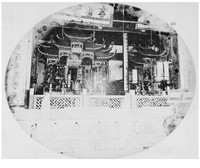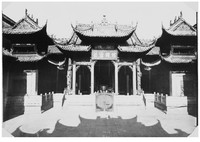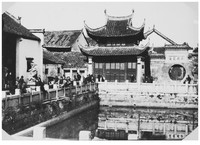Guilds and Commerce in Hankou
Hankou was a major commercial hub far before the city's concessions were constructed and foreign trade reached Wuhan's ports. After the start of foreign concessions in Hankou, Wuhan's reputation as the center of commerce in central China continued to grow. Both domestic and international trade in a wide range of goods formed a pivotal part of Hankou's economy, bringing wealth to the city's merchant class and leading to the creation of a commercial culture built around guilds and other organizations.
Hankou's Guilds:
Guilds can generally be understood to be economically oriented voluntary associations based in members' common type of work, common geographic origin, or common position in production or marketing hierarchy. A variety of organizational types fall under the category of "guild"; Some guilds were more formal and some guilds held more power than others. According to scholar William T. Rowe, guilds often served one or more of four main functions: cultural, commerical, corporate, and community service functions.
In terms of cultural functions, guilds were both cultural centers for their members and produce cultural works for the community at large. Guilds were more or less religious brotherhoods, and guildhalls often had a space for diety worship. To mark the completition of a guildhall or other achievement, or to honor a certain diety, guilds would put on theatrical productions. The guilds often included some sort of school for members' sons or others who were interested in the guild's speciality. The amount of focus on culture varied from guild to guild. In the post-Taiping Rebellion era, the cultural underpinnings remained but certain liberalizations and a stronger focus on economics took place.
Guilds in their commercial functioning worked largely as mediators. Guilds would mediate between individuals members, between members and outside people, and between groups. Further, guilds could regulate certain aspects of a trade. The administration generally supported this sort of regulation so long as prices did not rise too high or membership to the guild, and thereby entrance in the trade, was not too restricted. Guildhalls could also be hostels for traveling traders.
Guilds' corporate functioning dealt in their collective financial dealings. As a collective guilds built guildhalls and piers, and often owned other properties. (See below for images of some of the guildhalls in Hankou). The money for these projects was gathered through membership dues or entrance fees, as well as voluntary contributions from members. Some guilds' properties ended up spreading across several blocks of the city.
Finally, Guilds served important community-service or philanthropic functions. Some guilds, especially common-origin guilds, cited this community service as their primary goal. In Hankou (and other commercially-centered cities) gentry charity was replaced by guild charity. These philanthropic intiatives included firefighting and building of benevolent houses where people could stay without charge. The guild was the neighborhood patron and served as an intermediary between the neighborhood and the administration.
Bibliography:
For images
William T. Rowe. 1984. Hankow: Commerce and Society in a Chinese City Stanford: Stanford University Press


